Archaeologists are always on the ready for the next mythical idea of what we are and what we do. We don’t dig dinosaurs or find buried treasure (at least the kind that entails riches untold). We don’t all work in academia and, yes, our parents likely told us there were no jobs in archaeology.
We don’t typically run around, bullwhips a-blazing, yelling “It belongs in a museum!” We do like that particular Indiana Jones gem and many of the collections produced as part of the Pennsylvania Department of Transportation (PennDOT)-sponsored archaeological investigations are donated to the State Museum of Pennsylvania.
We’re far more likely to be found in a soggy hole on the side of the road quoting George R.R. Martin’s Stark clan with “Winter is coming!” as snowflakes swirl around us or telling our dig partner to keep an eye out to make sure we don’t “punch through the plowzone” and damage the integrity of intact archaeological deposits lying below the evidence of historic agricultural plowing activities.
In case you’re wondering, the plowzone is the top layer of soil through which a plow penetrates. Any archaeological deposits in that top layer would be disturbed by the plowing.
Most of the time, archaeology is an exercise in balancing the inherent destruction of a site by digging it with recovering as much data as we can to help us understand past peoples. In the case of the project described below, “punching through the plowzone” wasn’t a bad thing; it actually helped show us see the preserved picture of the prehistoric past lying intact below years of historic and modern plowing.
Archaeology and Lawrence County’s State Street Bridge
PennDOT and the Federal Highway Administration (FHWA) in coordination and consultation with the PA SHPO and consulting parties are responsible for ensuring that our projects avoid or minimize impacts to important resources. This is most commonly known as the Section 106 process. Depending on the type of activities (think bridge replacements, roadway realignments, etc.) and their proposed impacts to the landscape, PennDOT and FHWA will seek to understand the project’s potential to impact cultural resources by initiating identification-level studies, often referred to as Phase I investigation.
Phase I archaeological investigation includes a combination of background research, reconnaissance, and field testing efforts that can take a variety of forms. The ultimate objective of a Phase I archaeological investigation is to identify and inventory cultural resources within a project’s Area of Potential Effect (APE). Once complete, the Phase I archaeological survey will provide an agency with recommendations on the presence and potential significance of cultural resources. If a Phase I archaeological investigation identifies potentially significant cultural resources that will be impacted by the project, additional investigation called a Phase II evaluation is recommended.
In advance of the replacement of the State Route 0224 State Street Bridge spanning the Mahoning River in Mahoning Township, Lawrence County, Pennsylvania, archaeological investigations conducted from 2009 to 2010 on behalf of PennDOT and FHWA by A.D. Marble and Company resulted in the identification and evaluation of two previously recorded archaeological sites, the Edinburg Site (36LR0003) and the Ashton Cemetery Site (36LR0165) (White et al. 2010). A subsequent alignment avoided the Edinburg Site (36LR0003); however, impacts to the Ashton Cemetery Site (36LR0165), were unavoidable and additional investigation was recommended.
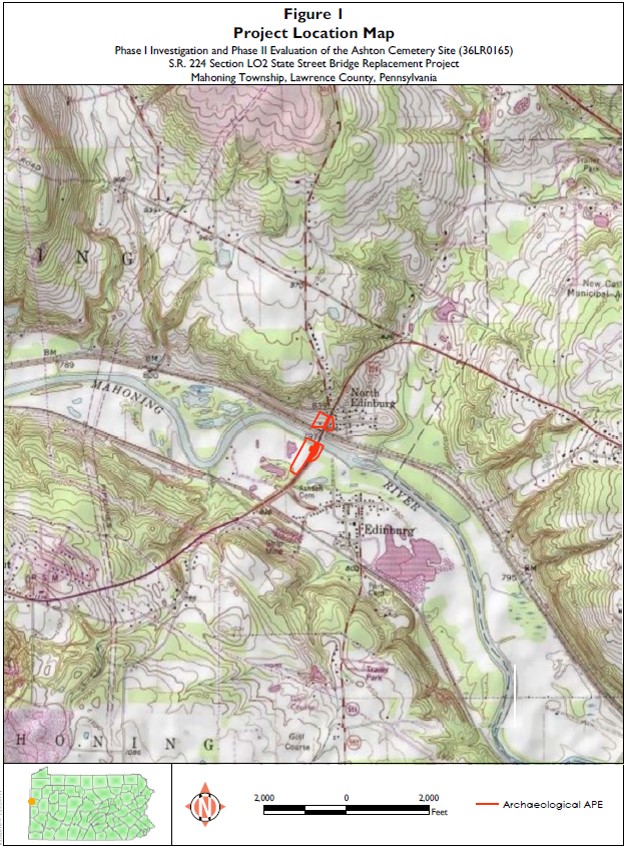
Project location shown on a USGS map. Image from White et al. 2010.
So, what did we find and what do we have to share you ask?
Originally recorded in 1951, the 2009 Phase I investigation of the Edinburg Site (36LR0003) recovered a total of 346 prehistoric artifacts and 86 historic artifacts from the Late Woodland period mound site (White et al. 2010).
Artifacts include ceramics, stone tools (lithics), and flake or debitage from stone tool-working. Following project design changes, avoidance of the Edinburg Site (36LR0003) meant that additional investigations were unnecessary as part of this project (White et al. 2010).
Phase I and II investigations of the Ashton Cemetery Site (36LR0165; previously identified as 36LR0102 in 1986) recovered 903 prehistoric and 78 historic artifacts from the Middle Woodland (300 B.C. to A.D. 900) to Late Woodland (A.D. 900 to A.D. 1600) camp site (White et al. 2010).
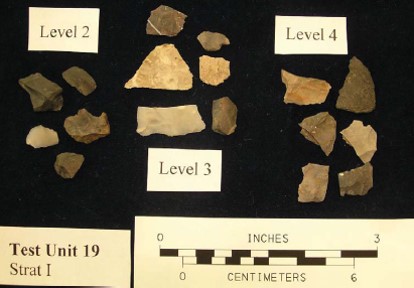
Lithic debitage recovered from the plowzone context of the Ashton Cemetery Site (36LR0165). Image from White et al. 2010.
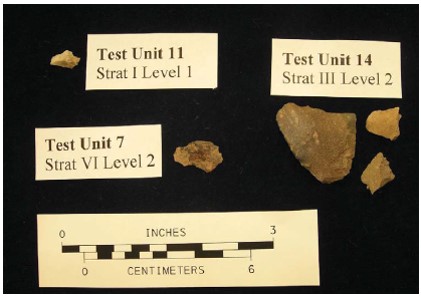
Lithic debitage recovered from the Bw-horizon (subsoil) context of the Ashton Cemetery Site (36LR0165). Image from White et al. 2010.
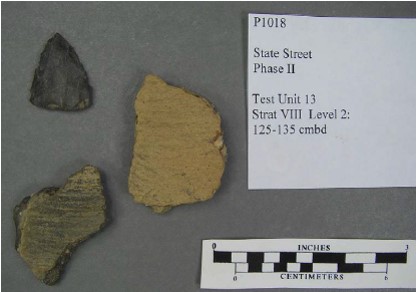
Cord-marked, grit-tempered ceramic sherds of Mahoning Ware and a triangle point recovered from the Ashton Cemetery Site (36LR0165). White et al. 2010.
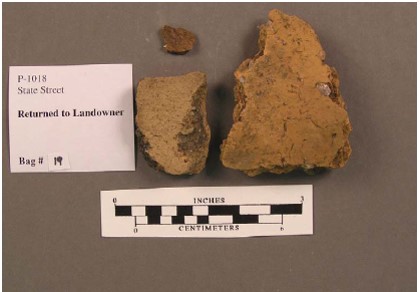
Smoothed exterior and shell-tempered ceramic sherds of Edinburg Phase Mahoning Ware recovered from the Ashton Cemetery Site (36LR0165). White et al. 2010.
The recovery of so many artifacts from both the plowzone, compromised of its integrity, and buried deposits allowed archaeologists to interpret several things about prehistoric lifeways in the region to include:
- “Relatively small, mobile groups [of Native Americans] with ample chert [flint] tool stone supplies [cobble and glacial deposits] occupied the site during the Middle and Late Woodland periods”;
- The site may have been significant as a “waypoint for logistically mobile [Native American] groups” that moved between places to harvest natural resources (like flora, fauna, and chert); and
- The site was a “well-known, potentially resource-productive location” and that site use was part of “a broader socioeconomic settlement pattern that was compelled by the need to acquire resources and/or possibly the need or desire to interact with other groups that inhabited the region (White et al. 2010)”.
Following the Phase I and II investigations, the Ashton Cemetery Site (36LR0165), was determined to be eligible for inclusion in the National Register of Historic Places. Following this determination, FHWA, PennDOT, PA SHPO, and other consulting parties to the project developed a Programmatic Agreement to mitigate for impacts to the site and development of an archaeological data synthesis for the relevant watershed was part of this agreement. Another part of this agreement included provisions to share and disseminate the findings of the investigations with the public and other interested parties.
Check out the results of the watershed research and the research questions posed found here: https://www.paprojectpath.org/docs/default-source/penndot-crm—general-documents/beaver-creek-watershed-synthesis-rpt_redacted.pdf?sfvrsn=2, and here: https://www.paprojectpath.org/penndot-crm/publications.
Check it out!
References Cited:
White, Richard, with Michael Lenert, Frank Mikolic, and Margaret Sams
2010 Phase I Archaeological Survey and Phase II Evaluation of the Ashton Cemetery Site (36LR0165) Management Summary. Report prepared for PennDOT Engineering District 11-0 by A.D. Marble & Company, Pittsburgh, Pennsylvania.
This week’s post is by guest author, Angela Jaillet-Wentling, a PENNDOT CRP Archaeologist, Districts 11-0 and 12-0.
Angie Jaillet-Wentling is a Historic Preservation Specialist for the Pennsylvania Department of Transportation (PENNDOT) specializing in archaeology. She covers seven counties in southwestern Pennsylvania’s Engineering Districts 11-0 and 12-0. You can reach her at ajailletwe@pa.gov.
Comment Policy
PHMC welcomes and encourages topic-related comments on this blog. PHMC reserves the right to remove comments that in PHMC’s discretion do not follow participation guidelines.
Commenters and Comments shall be related to the blog post topic and respectful of others who use this site.
Commenters and Comments shall not: use language that is offensive, inflammatory or provocative (this includes, but is not limited to, using profanity, obscene, or vulgar comments); disparage other commenters or people; condone illegal activity; identify the location of known or suspected archeological sites; post personal information in comments such as addresses, phone numbers, e-mail addresses or other contact details, which may relate to you or other individuals; impersonate or falsely claim to represent a person or an organization; make any commercial endorsement or promotion of any product, service or publication.
If you would like to comment on other topics not related to this blog post but related to PHMC, please fill out the PHMC Contact Us Form.
Wonderfully written!
it was very help full for my new site.